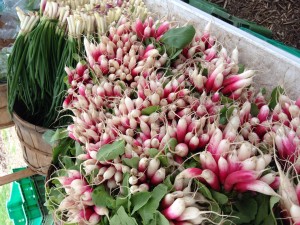
I remember my first encounter with ramps (no, not the kind you drive or walk on, that wouldn’t be a very nutritious topic), it was during my culinary externship. Everyone in the kitchen was out-of-their minds excited about a shipment of ramps that were arriving shortly. I, of course, pretended to be “in” on the ramp excitement. Nodding my head and grinning, acting like I was a ramp expert. No way was I going to let these guys know I didn’t know what a ramp was! The buzzing in the kitchen was escalating and pens and notepads were taken out and millions of ramp recipes were created. The whole time I kept thinking, “all of this excitement for a vegetable!?” I couldn’t wait to see what this stuff was! It had to be amazing. When it arrived, I have to admit I was a little disappointed. All of that clamoring over this thing that looked like a lost cousin to a green onion? Seemed crazy to me. Well, then I got a lesson. Because one of those chefs figured me out and immediately gave me a solid education on ramps. Then, because he was a good guy, he showed me how to cook it and then, magically, I got it! Thank goodness!
With my new appreciation of ramps, I can now say that I look forward to their arrival at the local farmer’s market. That’s because they are the indication that Spring has officially arrived. These delicious little vegetables are members of the allium family (along with onions, garlic, scallions, etc) and are wild-harvested, meaning they aren’t cultivated like most crops. Magnifying their desirability is the fact that they are only available for a short window of time during April and early May. This is why you’ll see them scooped up as soon as they’re set on the table at the market. They look a little bit like green onions, but you’ll know they’re ramps because of their distinctive flat leaves and burgundy stems. As for taste, these little guys pack a strong flavor. It’s a bold, almost wild taste of onion and garlic. While they can be eaten raw, many people prefer it cooked, which eliminates some of that piquant taste. My favorite way to eat them is to toss them lightly with olive oil, salt and black pepper and then grill them. Easy and delicious! Serve them as a side dish to any meal or chop and add to salads or pasta.
Oh yes, you are wondering about the nutritional value, aren’t you? Of course! Well, let’s just say they are loaded with Vitamin A (eat the leaves to get this powerful antioxidant) as well as Vitamin K, folate, iron and manganese. And you can be sure there are other disease-fighting phytochemicals in there too.
You’ve got a few more weeks until ramps arrive, so get your recipes ready!



